Chapel and cult of Our Lady of La Salette in Villers-sur-Semois
Chapel dedicated to Our Lady of La Salette

It is located at the exit of Villers-sur-Semois, left going towards Mortinsart.
It should be Father Burtombois, a Belgian priest ordained in France, who introduced this cult in Villers, where he was parish priest between 1820 and 1847.
At La Salette, near Grenoble, the Virgin would have appeared to Mélanie and Maximin, two little shepherds, in 1846.
The chapel was built in 1946 under the pastorate of Father Léon Chenot, parish priest of Villers from 1930 to 1950.
It is the exact replica of the chapel erected at the scene of the accident which caused the death of Queen Astrid in 1935 in Kussnacht, Switzerland.
A pilgrimage is organized to the chapel on the third Sunday of September.
What is the story of these apparitions of the Virgin at La Salette?
The presumed apparitions of the Blessed Virgin in La Salette.
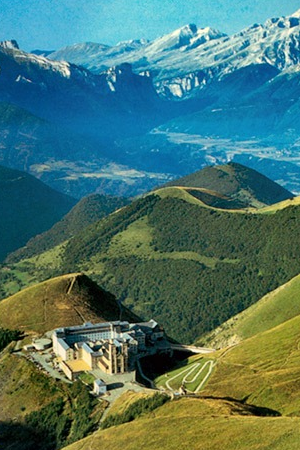
La Salette-Fallavaux is a village in France, in the Isère department, in the heart of the Alps,
70 km south of Grenoble, between the Beaumont massif and the Valgaudemar valley.
At an altitude of nearly 1800 metres, the site is difficult to access.
Until the mid-nineteenth century it was wild and unknown.
Only a few shepherds with their flocks ventured on the slopes of Mount Gargas, culminating at 2208 meters, to enjoy the alpine pastures.
The village of La Salette is small and is home to only a few dozen inhabitants.
It can be considered a hamlet of Corps, a few kilometers further south.
From the houses of the village, to reach the place of our history, it is necessary to walk narrow paths and walk through huge pastures.
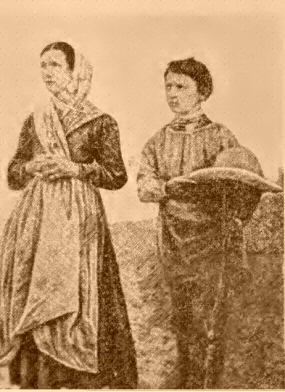
This is what Mélanie and Maximin, two children of Corps, did on the afternoon of September 19, 1846.
Pierre-Maximin Giraud is 11 years old and the fourth child in a modest family.
He was orphaned by his mother shortly after his birth and his father remarried, but Maximin remained the family's whipping boy.
He did not attend school, cannot read or write and speaks only the local dialect.
He is an "innocent without malice", but quite rude, lively and angry.
Shortly before September 19, his father loaned him for a few days to a nearby farmer to replace his sick domestic worker.
Françoise-Mélanie Mathieu is almost 15 years old. She is the fourth child in an indigent family.
In its tenth year, she was placed in service with farmers in the region. She only spends at her father's home in the winter months.
She is also illiterate.
Frustrated with affection and used to spending long days alone with her flocks, she has a closed character.

For a few days, the two children have found themselves in the alpine pastures guarding the cows of their masters.
They got along well and, on September 19, met to leave together in the morning, each driving four cows to Mont-sous-les-Baisses.
Maximin also takes his dog and his father's goat.
His master mows a meadow not far from where the children keep the animals. Knowing the child's dizziness, he prefers to watch him from afar.
At noon, after eating some bread and cheese, Mélanie and Maximin fall asleep, lying in the grass near a stream.
When they wake up, around three o'clock in the afternoon, the children worry about their animals, but find them all a little further away.
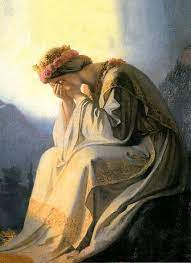
As she descends near the beasts, Melanie utters a loud cry: she sees a sun-like clarity.
She calls Maximin and the children see the clarity open and discover in the middle the shape of a seated woman,
head between hands and elbows on knees.
The children are frightened, but the lady gets up and tells them:
"Move forward my children, do not be afraid, I am here to tell you great news."

The Lady, all of light, carries on her chest a crucifix, a hammer and pincers.
She then gave them this somewhat strange speech, first in French, then in the dialect of Corps :
"If my people do not want to submit, I am forced to let go of my Son's arm.
It is so heavy and so heavy that I can no longer hold it back.
Since the time I suffer for you !
If I want my Son not to abandon you, I am responsible for praying to him constantly for you and you ignore that, you do not care!
No matter how much you pray, no matter how hard you do, you will never be able to reward the pain I have taken for you!
I gave you six days to work, I reserved the seventh and they do not want to give it to me.
This is what makes my Son's arm so appeal!
Those who drive carts do not know how to swear without putting the name of my Son!
These are the two things that so linger on my Son's arm.
If the harvest spoils, it is just because of you I showed it to you, last year, by the potatoes :
you have not taken it into account , it is on the contrary, when you found spoiled ones, you swear, you put the name of my Son.
They will continue to rot and at Christmas there will be none."
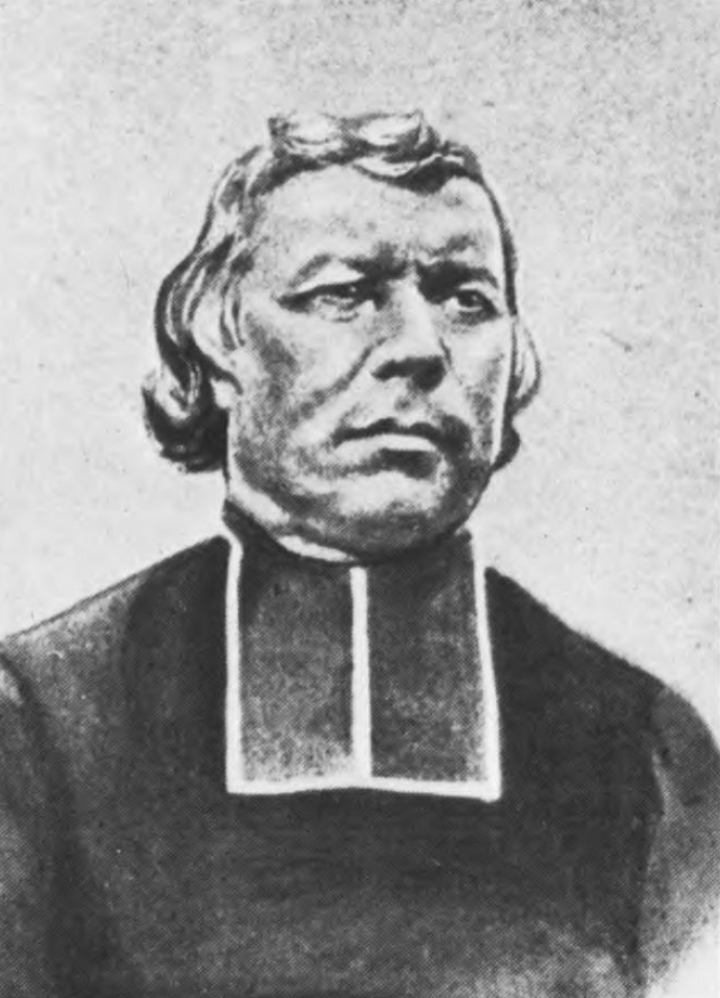
When the children return, Maximin tells his boss about the events and Mélanie later confirms the facts.
The two masters, that of Mélanie and that of Maximin, send the children to the old parish priest of La Salette Jacques Perrin, who,
in the grip of the greatest excitement, immediately announces the news in the pulpit of truth, as it was a Sunday.
This old parish priest was replaced by another Perrin, Father Louis Perrin, on September 28, 1846.
Later, the case was highlighted by Abbé Melin, parish priest of Corps (see his portrait above).
He takes water from the fountain near the place of the apparition and makes the noise that it is miraculous.
He wrote several times to the Bishop of Grenoble to express his conviction that the Virgin had indeed appeared at La Salette.
The news spread very quickly and, just a few days after the event, hundreds of pilgrims arrived on the scene
and healings are attested. There is even a rain of red mud that is attributed to the curse announced by the Lady.
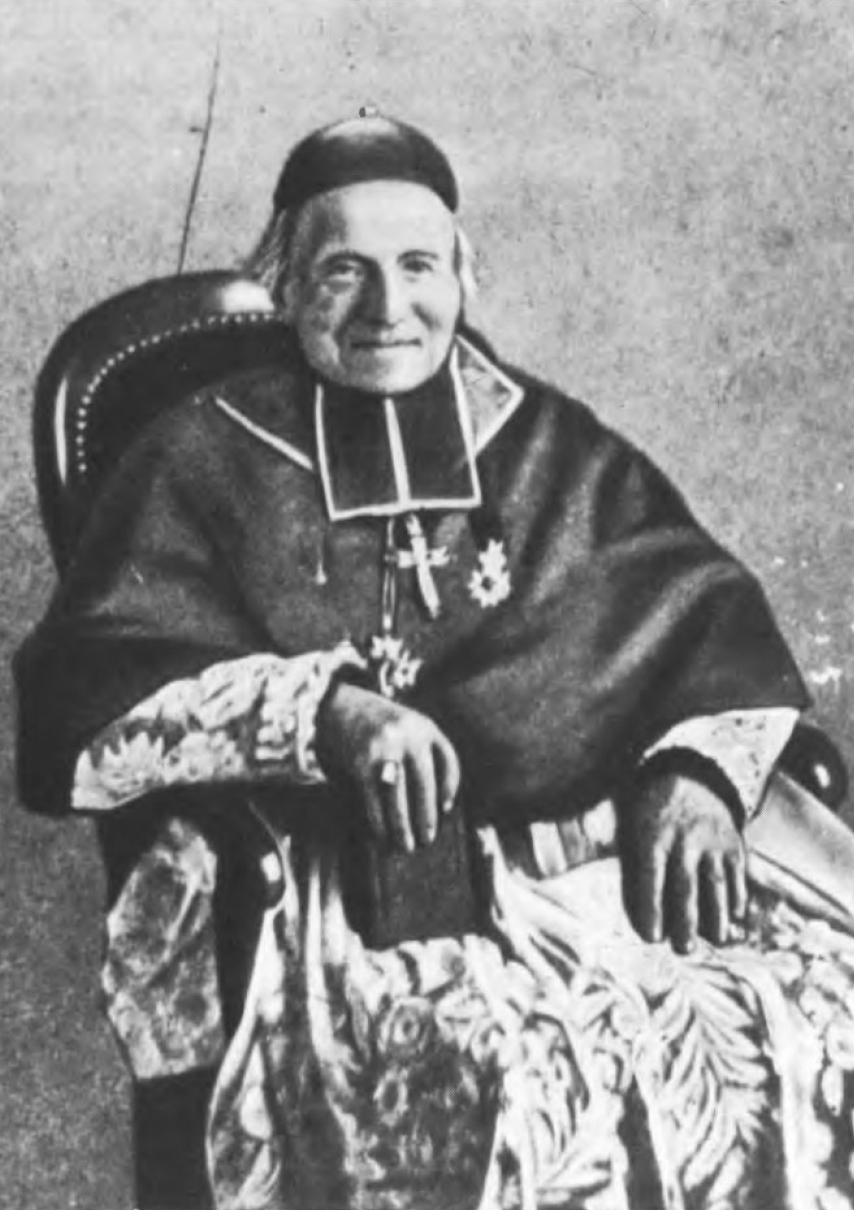
Monseigneur de Bruillard, Bishop of Grenoble, already in his eighties, is a little overwhelmed by events
and it was only in July 1847 that he issued an order to open an inquiry in order
to know if the Virgin Mary had really appeared to the two shepherds, taking care, however to place in the commission
a majority of people in favour of the certification of the apparition.
Indeed, it is clear that the churches are filling up better than before and that the fervor is becoming more and more important in the region.
The parish priests also took the opportunity to ask for financial assistance from the bishopric, in order to improve the comfort of the presbytery and the church.
This investigation lasted two years and the report of 1848 concluded that the miracle of the apparition existed.
Canon Rousselot, ardent defender of the miracle, wrote in 1849 a "Manual of the pilgrim to Notre-Dame de La Salette".
In 1851, he wrote to the bishop: "It would therefore be appropriate, Monseigneur, to finish promptly, with the people of La Salette;
they were already well disposed, it is a question of not letting them cool down, and to quickly conclude."
This was done by the bishop on September 19, 1851, by ratifying the investigation report and officially recognizing the apparition.
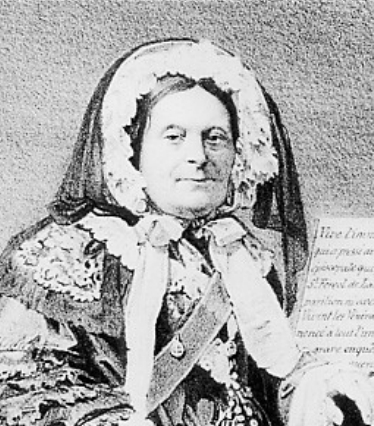
And yet, doubt has set in, including among members of the clergy.
It must be said that everything is based on a single alleged apparition and on the sole testimony of two teenagers.
The Lady's words seem quite strange, as well as the fact that she spoke the dialect of Corps.
If we add again that his prophecies have not been fulfilled and that the so-called "healings" seem to
highly exaggerated, it is quite logical that several people react.
So, Father Déléon, former parish priest of Villeurbanne, published an article entitled "La Salette, valley of lies.".
In September 1854, he highlighted the deception, claiming that a lady Constance Saint-Ferréol de La Merlière,
former nun of Providence (see illustration), had pretended to be the Virgin Mary to the children.
A stagecoach driver states that, just at the time of the apparition, he brought to La Salette Miss de La Merlière,
known throughout the country for her eccentricities, that he lowered her to the foot of the mountain and that she told him, with great exaltation:
"I'm going to do a brilliant action; they will talk about me in posterity."
A few days later, the same lady showed herself, dressed in the same costume that the Virgin had appeared to the little shepherds,
that is, a yellow dress on which were embroidered the instruments of passion and a sugar loaf hat.
This costume was also seen at her home by a neighbor.
Subsequently, the lady lost two lawsuits concerning these accusations.

Despite this, the Virgin of La Salette is still venerated and is the subject of pilgrimages.
In 1851, Mélanie took the habit under the name of Sister Marie de la Croix, but was not admitted to the profession of faith.
because she is considered "completely crazy".
After several wanderings between England, France and Italy, she wrote an autobiographical text
in which she explains that at the age of three, she had played with little Jesus in the forest.
This text is considered to have been written by a hysterical and mythomaniac woman.
As for Maximin (see illustration), he continues to blaspheme and to be unable to learn and work.
He sometimes admits that the apparition was a deception and falls into idleness, wandering and drunkenness.
Whatever the opinions, it is true that the appearance of La Salette always involves a significant number of questions and contradictions.
An investigation too late, conducted in one direction by some members of the clergy who wanted to believe it,
Easily generates one-sided testimonies that do not commit to admitting the truth of the apparition without being very critical.
Finally, can we trust the "miracle" of La Salette?
Given the evolution of events after the apparition of the "lady" at La Salette, it is permissible in any case to ask questions
concerning the veracity of the testimonies of the two children.
In any case, supporters and opponents remained on their positions.
Father Deleon continued to repeat his skepticism over and over as the defenders of the miracle dismantled all his arguments.
In particular, they considered it impossible that the old lady of the Merlière could have climbed to the place of the apparition and
"rise in the air" and then disappear.
As for the opponents of the miracle, they considered, like the vicar general Berthier, "that by dint of multiplying the wonders, one offended faith as much as common sense"
or that "these clergymen (nb: the "defenders" during the investigation) consider that it is sufficient that a fabrication is generally accepted for it to be admitted that it is founded."
In short, an opposition between the two camps that has not changed the exact knowledge of the facts.
In any case, this did not prevent devotion to Our Lady of La Salette.
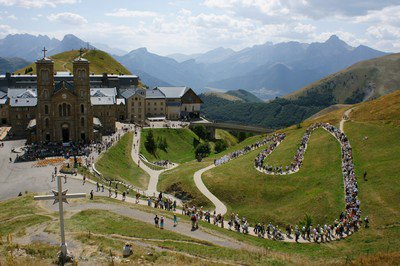 The clergy continued to advocate the miracle, and pilgrims continued to abound and claim to be miraculous.
The clergy continued to advocate the miracle, and pilgrims continued to abound and claim to be miraculous.
Even, the repercussions of the debates led to a redoubling of fervor, by reaction, by instinctive need to protest against the alleged blasphemy of disbelief or simple critical thinking.
A basitic was built, flanked by two coprs of buildings and able to accommodate 600 people, and pilgrimages were organized, which are still frequented assiduously today.
And, more than a century after the events, the fervor remains intact, up to Villers-sur-Semois
Not only was the chapel built there in 1946, but several objects of worship bear witness to the special devotion to this Virgin:
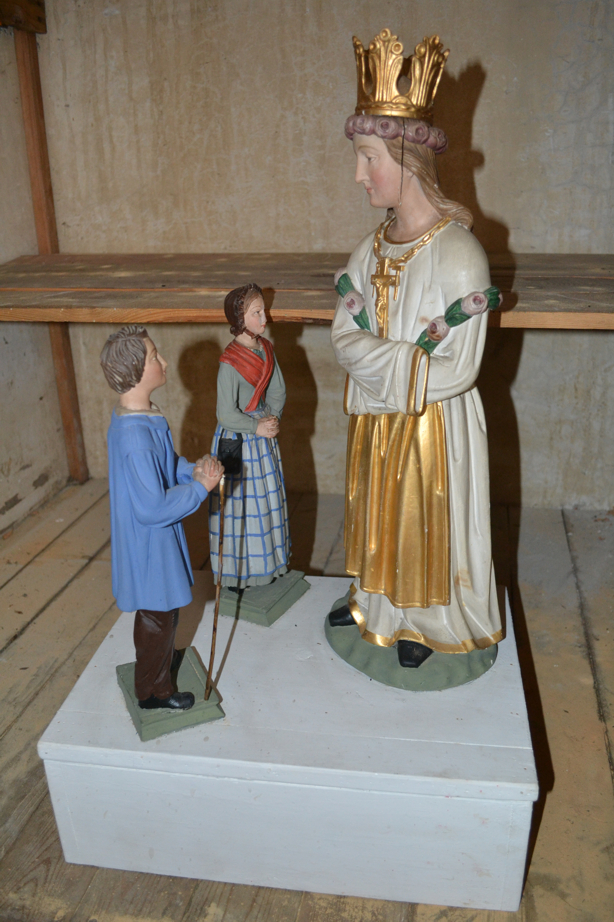
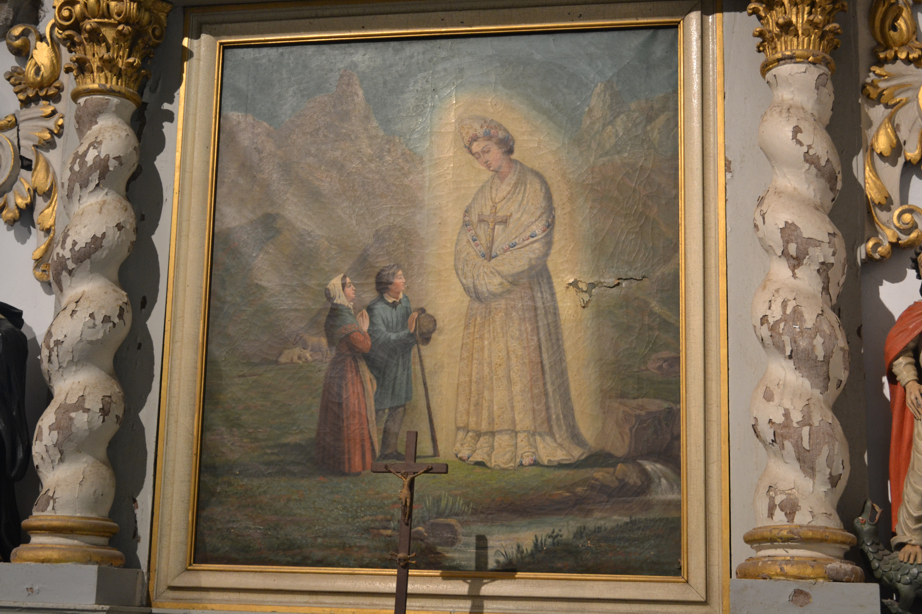

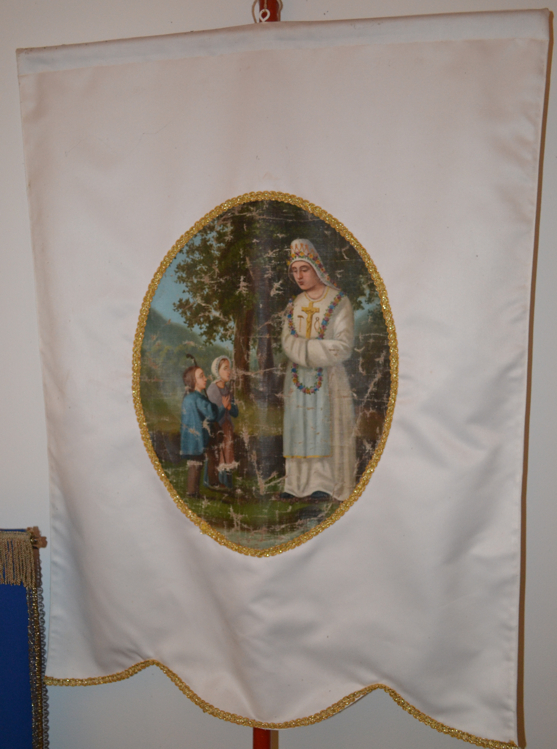
- a very beautiful polychrome wooden statue, which unfortunately is hidden in a wardrobe on the rood screen of the church,
- a painting on the altarpiece of the right side altar in the church,
- a stained glass window of the church representing the children and the Lady,
- a banner used for processions to the chapel.
In the end, it doesn't matter...
Whether the Virgin actually appeared to the two children or not, the result is there:
devotion is present and believers practice their faith in the Virgin of La Salette.
I would be inclined to conclude that faith does not need miracles and mystery.
The real miracle is the fervor and love of those who believed in it.
So let's end with the sentence of the famous Miss de la Merlière herself,
by addressing the driver of the stagecoach who had taken her to the foot of the mountain
and who, later, was offended that one believes in an apparition of the Virgin:
"Allow you not to believe anything; but let others believe; it does good to religion."
Bibliography
- Stern, J. La Salette - Documents authentiques - dossier chronologique intégral - Volume 1 : septembre 1846 - début mars 1847. - 417p. - 1980 - ed. Desclée de Brouwer, Paris
- Stern, J. La Salette - Documents authentiques - dossier chronologique intégral - Volume 2 : fin mars 1847 - avril 1849. - 385p. - 1984 - Les éditions du Cerf, Paris
- Hallet, M. Les apparitions de la Vierge et la critique historique. - 422p. - 2015 - Edition électronique, Liège
- Larousse, P. La Salette-Fallavaux in Grand dictionnaire Larousse du XIXe siècle.
- La Salette-Fallavaux in Encyclopédie en ligne Imago-Mundi.